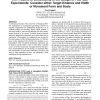Free Online Productivity Tools
i2Speak
i2Symbol
i2OCR
iTex2Img
iWeb2Print
iWeb2Shot
i2Type
iPdf2Split
iPdf2Merge
i2Bopomofo
i2Arabic
i2Style
i2Image
i2PDF
iLatex2Rtf
Sci2ools
CHI
2009
ACM
2009
ACM
The problem of consistency in the design of Fitts' law experiments: consider either target distance and width or movement form a
An intriguing anomaly of the usual way of designing Fitts’ law experiments in experimental psychology and HCI is exposed: experiments are traditionally designed so as to carefully balance two ancillary factors, target distance D and target width W, but not task difficulty, the factor unanimously thought to be crucial. Troubling factor confounds and hence quantitative estimation errors result from this inconsistency. The problem, it is suggested, may be fixed if the equivocalness of the fractional expression D/W that appears on the right-hand side of Fitts’ law equations is acknowledged. This two-degree-of-freedom expression can be taken to specify either D and W or the form F and the scale S of the movement task. The paper ends up with practical recommendations for the design of consistent Fitts’ law experiments. In most cases eliminating one factor will allow a safer estimation of Fitts’ law parameters, while simplifying the experimental work. Author Keywords Fitts’ law, ex...
| Added | 22 Jul 2010 |
| Updated | 22 Jul 2010 |
| Type | Conference |
| Year | 2009 |
| Where | CHI |
| Authors | Yves Guiard |
Comments (0)

